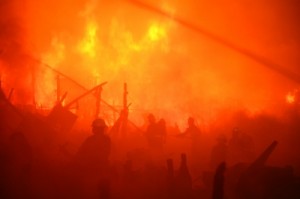Home insurance, aka. homeowner’s insurance (often abbreviated HOI) aka. hazard insurance, is an insurance policy that combines various forms of risk liability that pertain to private home ownership.
For instance as a homeowner you are at risk for damage to the structure of your home through various things like fire, storm damage, frozen pipes, etc. But you are also liable for loss of contents due to theft damage etc. But you might also be sued by a visitor or contractor working on your priperty due to some sort of hazard on your property.
The term homeowner implies that at least one of the named insureds is an occupant of the home. Homeowner insurance generally covers both property insurance and liability coverage.
Cost of Home Owner’s Insurance
 Cost is determined by the value of the home and contents and the level of liability coverage included. Typically insurance is based on “replacement cost” which is substantially different than “market value” especially for contents. Market value would be what you would get for an item if sold on eBay or at a garage sale which is generally considerably less than the cost of buying the item new at a store.
Cost is determined by the value of the home and contents and the level of liability coverage included. Typically insurance is based on “replacement cost” which is substantially different than “market value” especially for contents. Market value would be what you would get for an item if sold on eBay or at a garage sale which is generally considerably less than the cost of buying the item new at a store.
Certain situations can reduce your cost of insurance if they reduce the likelihood that a claim will be made. Things like if the house is equipped with a security or fire alarm, fire sprinklers, insurer-approved locks, or hurricane shutters can reduce the cost of insurance as can proximity to a fire station or fire hydrant.
Exclusions
Standard exclusions generally include:
- Claims due to floods
- Claims due to war
- Naturally occurring things like Termites
Special insurance can be purchased to cover these risks but flood insurance is often expensive even if you live on top of a hill with an extremely low risk of flooding.
Required Coverage
In the United States, if you have a the mortgage lender will require homeowner’s insurance as a condition of the loan, in order to protect the bank if the home were to be destroyed. Anyone with an insurable interest in the property should be listed on the policy. Often to verify that the insurance premiums and taxes are paid the bank will collect the insurance premiums and taxes along with the mortgage and hold them in escrow and make the payments directly to the insurance company and taxing authority.
Standard Homowner’s Policies
There are seven standardized homeowners insurance types in general use:
- HO1 – Basic Form Homeowner Policy
- A basic policy form that provides coverage on a home against 11 listed perils; contents are generally included in this type of coverage, but must be explicitly enumerated. The perils include fire or lightning, windstorm or hail, vandalism or malicious mischief, theft, damage from vehicles and aircraft, explosion riot or civil commotion, glass breakage, smoke, volcanic eruption, and personal liability. Exceptions include floods, earthquakes. Most states no longer offer this type of coverage.
- HO2 – Broad Form Homeowner Policy
- A more advanced form that provides coverage on a home against 17 listed perils (including all 11 on the HO1). The coverage is usually a “named perils” policy, which lists the events that would be covered.
- HO3 – Special Form Homeowner Policy
- The typical, most comprehensive form used for single-family homes. The policy provides “all risk” coverage on the home with some perils excluded, such as earthquake and flood. Contents are covered on a named peril basis. (Note: “All Risk” is poorly termed as it is essentially named exclusions (ie, if it is not specifically excluded, it is covered))
- HO4 – Renter’s Insurance
- The “Tenants” form is for renters. It covers personal property against the same perils as the contents portion of the HO2 or HO3. An HO4 generally also includes liability coverage for personal injury or property damage inflicted on others.
- HO5 – Premier Homeowner Policy
- Covers the same as HO3 plus more. On this policy the contents are covered on an open peril basis, therefore as long as the cause of loss is not specifically excluded in the policy it will be covered for that cause of loss. (can also be achieved by endorsing an HO15 to the HO3)
- HO6 – Condominium Policy
- The form for condominium owners.
- HO8 – Older Houses
- The “Modified Coverage” form is for the owner-occupied older home whose replacement cost far exceeds the property’s market value. HO8, is likely to pay only actual cash value for damages rather than replacement
For each policy, there are typically 5 classifications of coverage. These are based on standard Insurance Services Office or American Association of Insurance Services forms.
- Section I — Property Coverages
- Coverage A – Dwelling
- Covers the value of the dwelling itself (not including the land). Typically, a coinsurance clause states that as long as the dwelling is insured to 80% of actual value, losses will be adjusted at replacement cost, up to the policy limits. This is in place to give a buffer against inflation. HO-4 (renter’s insurance) typically has no Coverage A, although it has additional coverages for improvements.
- Coverage B – Other Structures
- Covers other structure around the property that are not used for business, except as a private garage. Typically limited at 10% to 20% of the Coverage A, with additional amounts available by endorsement.
- Coverage C – Personal Property
- Covers personal property, with limits for the theft and loss of particular classes of items (e.g., $200 for money, banknotes, bullion, coins, medals, etc.). Typically 50 to 70% of coverage A is required for contents, which means that consumers may pay for much more insurance than necessary. This has led to some calls for more choice.
- Coverage D – Loss of Use/Additional Living Expenses
- Covers expenses associated with additional living expenses (i.e. rental expenses) and fair rental value, if part of the residence was rented, however only the rental income for the actual rent of the space not services provided such as utilities.
- Additional Coverages
- Covers a variety of expenses such as debris removal, reasonable repairs, damage to trees and shrubs for certain named perils (excluding the most common causes of damage, wind and ice), fire department changes, removal of property, credit card / identity theft charges, loss assessment, collapse, landlord’s furnishing, and some building additions. These vary depending upon the form.
- Exclusions
- In an open perils policy, specific exclusions will be stated in this section. These generally include earth movement, water damage, power failure, neglect, war, nuclear hazard, septic tank back-up expenses, intentional loss, and concurrent causation (for HO-3).
See Also:
- 5 Good Reasons To Get Title Insurance
- Financial Jargon- Investment Terminology for Beginners
- The importance of UK Home Insurance
- Insurance 101: All You Need To Know About Insurance
- The Differences Between Term and Whole-Life Insurance
- First Time Home Buyers Need Budgeting Skills
- Why People Pay More for Home Insurance Than They Need To
Recommendations from Amazon:
- Questions and Answers on Life Insurance: The Life Insurance Toolbook
- Insurance for Dummies
- What Most Life Insurance Agents Won’t Tell You
- Revealing Life Insurance Secrets: How the Pros Pick, Design, and Evaluate Their Own Policies
Image courtesy of think4photop / FreeDigitalPhotos.net
